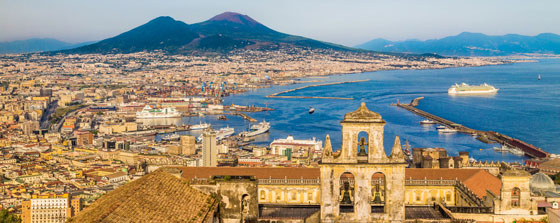
Spring in Naples is an attractive season. The warm sun makes the water in the bay sparkle and the atmosphere remains clear. The temperature is pleasant, the green slopes of Vesuvius stand out in the limpid air and the burning summer temperatures have not yet arrived. In the distance the Isle of Capri abandoned by the invading hordes of tourists seems ready to make landfall. Out in the roadstead the Castel del Ovo built to withstand the battering of the worst storms is visited by swooping seagulls while the golden mimosa flowers light up the hills around Santa Lucia in the gentle breeze blowing off the sea.
In 2005 the men of the Guardia di Finanza no doubt took advantage of this spring air to take a walk to Sarno at the foot of Mount Vesuvius. A pleasant outing for what was expected to be a routine inspection of a suspect warehouse. They could not have imagined just how far this first investigation would take them. Ten years have gone by and on the desk in the public prosecutor’s office, a cubic metre of documents summarises this decade of investigations which «Dottore» Ernesto Caggiano, president of the Court of Nocera Inferiore, is trying today to summarize. The 10,000 counterfeit articles seized in Sarno in 2005 were no more than the visible part of the iceberg. Since that spring excursion, dozens of suspect individuals have had to be given a hearing and hundreds of telephone taps transcribed. The further the investigation advanced the more ramified the network became, involving whole families of Chinese citizens. Taking advantage of their physical similarities and their almost identical names, carrying identity documents which seemed to be interchangeable the suspects knowingly maintained the utmost confusion. One day cousins, the next persons who did not know one another. One day married, single the next. Better still: one suspect continued to answer the police summons several months after his death. Even the Chinese interpreters appointed by the Courts threw in the sponge, incapable as they were of translating into Italian the Chinese patois and the language codes used by the suspects between them. To cap it all a few individuals made a spontaneous confession and took all the accusations upon themselves, willing to go to prison straight away to expiate the wrongdoings of the clan. The investigators did not fall for such a crude trick: paid to go to prison, the «volunteer perpetrators» (could there be a more idiotic trick?) were sent straight back to their bosses in China. Weary of all these proceedings and unable to associate a voice with a particular identity the policemen had the brilliant idea of using the technique of acoustic fingerprints. A sound engineer was called in to map hundreds of acoustic fingerprints of all these crooks. After months of meticulous comparisons the expert was finally able to give a name to a voice and so confirmed that the accused X was indeed the person who called the accused Y on the telephone, despite all his denials. From then on the outline of this immensely complicated network gradually took clearer shape.
On 9 March, the Court of Nocera decided to return in detail to the technical investigations performed by the Counterfeiting Prevention Service of the FH in this most unusual investigation. The conclusions of the FH confirm the other elements of the police investigation. All the counterfeit products analysed were made in China between 2003 and 2005 and then shipped in component form to Italy. The goods were delivered to Naples and taken on to Sarno and Pisa for assembly in three clandestine workshops before being distributed all over Europe, even in Switzerland. A Chinese carrier belonging to this network was arrested by the Swiss customs officers in Chiasso. Over the estimated period of activity several hundred thousand pieces were sold in this way. The defendants did all they could to minimize the volumes involved but without success. In this particularly complex investigation the Public Prosecutor’s Office greatly appreciated the technical assistance provided by the FH and Dr Caggiano ended the hearing with a vote of thanks. The judgement will be handed down in the summer.
March 26, 2015


 News
News